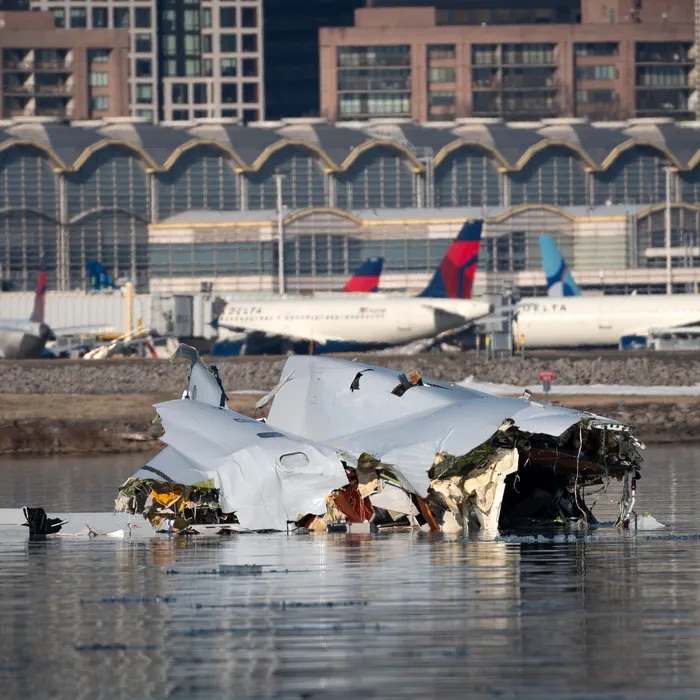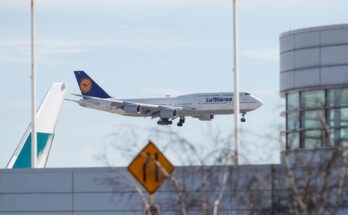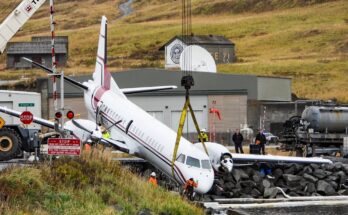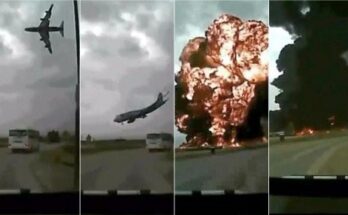
On January 29, 2025, a Bombardier CRJ700 airliner operating as American Airlines Flight 5342 (operated by PSA Airlines as American Eagle)[b] and a United States Army Sikorsky UH-60 Black Hawk helicopter operating as Priority Air Transport 25collided mid-air over the Potomac River in Washington, D.C.. The collision occurred at 8:47 p.m. at an altitude of about 300 feet (100 m) and about one-half mile (800 m) short of runway 33 at Ronald Reagan Washington National Airport in Arlington, Virginia. All 67 people aboard both aircraft were killed in the crash, including 64 passengers and crew on the airliner and the three crew of the helicopter. It was the first major US commercial passenger flight crash in nearly 16 years since Colgan Air Flight 3407 in 2009, and the deadliest US air disaster since the crash of American Airlines Flight 587 in 2001
The jet was on final approach into Reagan National Airport after flying a scheduled route from Wichita Dwight D. Eisenhower National Airport in Wichita, Kansas, to D.C, while the helicopter crew was performing a required annual flying evaluation with night vision goggles and had left from Davison Army Airfield in Fairfax County, Virginia. Both aircraft communicated with air traffic controlbefore they collided. The helicopter crew reported twice that they had visual contact with the airliner and would maintain separation from it, although it is unknown whether they were monitoring the correct aircraft. The crew of the Black Hawk did not hear parts of the tower communication due to a mic press.
On March 11, the National Transportation Safety Board (NTSB) released a preliminary report and urgent safety recommendations, emphasizing the dangerously narrow vertical separation between the runway approach path and the helicopter route. The NTSB chair also expressed anger that the Federal Aviation Administration (FAA) did not act on data showing the number of near-miss alerts over the last decade.

Aircraft
Flight 5342 was operated by a 20-year-old Bombardier CRJ700, a regional jet commonly used for short- to medium-haul flights. It was configured as a CRJ701ER, denoting a slightly higher seating capacity and extended range. Manufactured in September 2004, it bore the manufacturer’s serial number 10165 and was registered as N709PS.[10][11]PSA Airlines is owned by the American Airlines Group,[12] which is also the parent company of American Airlines.[13]No problems were reported as the plane took off from Wichita on its way to Washington.[4][3] Flight 5342’s route was only one year old.[14] For many years, Kansas residents had needed to drive to adjacent Missouri and Oklahoma if they wanted to take long-distance flights.[14]A year earlier, local leaders had finally convinced American Airlines to establish direct passenger air service from Kansas to the East Coast.[14]
The helicopter involved was a US ArmySikorsky UH-60L Black Hawk[15]registered as 00-26860.[5] The helicopter was configured for use as executive transportation for senior US officials and soldiers, and was flying under the callsign PAT25 indicating a “Priority Air Transport” flight.[3][16] No senior officials were on board the helicopter.[3][16] The helicopter, of B Company of the 12th Aviation Battalion at Fort Belvoir, was on an annual and night vision goggles check flight out of Davison Army Airfield when the collision occurred.[17][18][6] The helicopter was part of the Continuity of Government Plan, with the flight being a routine re-training of aircrew in night flight along the corridor. In emergencies, elements of the US government would use it to evacuate the capital.[19]

Passengers and crew
See also: § Casualties
PAT25
The helicopter had a crew of three Army personnel:
- Captain Rebecca Lobach, 28, was the pilot flying and undergoing her annual night flying evaluation. She had accumulated 450 flight hours at the time of the crash, with 326 on UH-60 type helicopters.[20][21][22][7]: 3
- Chief Warrant Officer 2 Andrew Eaves, 39, was the evaluator for Lobach and was serving as the pilot monitoring who primarily communicated with air traffic controllers. He had 968 flight hours, with 300 on the UH-60.[23][24][25][7]: 3
- Staff Sergeant Ryan O’Hara, 29, was the crew chief (aircraft maintenance technician), with 1,149 flight hours, all being on the UH-60.[26][13][7]: 3
Flight 5342
The airliner carried 60 passengers and 4 crew members: a captain, a first officerand two flight attendants.[7]: 1, 3 The captain, Jonathan Campos, 34, was the pilot flying and had been with the airline for six years. He had logged 3,950 flight hours, including 3,024 on CRJ-series aircraft, and was a Federal Flight Deck Officer.[7]: 3 [27] The first officer, Samuel Lilley, 28, was the pilot monitoring. He had worked for the airline for two years and accumulated 2,469 flight hours, with 966 on the CRJ.[7]: 3
Ronald Reagan Washington National Airport
The airspace around Reagan National Airport is among the world’s most complex and closely monitored, with restrictions on both sides of the Potomac River to protect government buildings in Washington, D.C.[28] Efforts have been made to reduce congestion, but in 2024, Congress approved additional flights.[29]Military helicopter operations further complicated the airspace, including a helicopter corridor which passes within 15 feet (4.6 m) vertically of the approach to runway 33.[30]
Reagan National has three runways: 1/19, 15/33, and 4/22. Runways 1/19 handle 95% of commercial aircraft arrivals. Runway 33 handles about 4%, and runway 15—due to its close proximity to the Pentagon[citation needed]—handles less than 1%.[7]: 18 Runways 4/22 are too short for commercial aircraft.[citation needed]During north operations, which were in effect at the time of the collision, most arrivals occur on runway 1, with intermittent arrivals on runway 33, depending on traffic demands and separation requirements.[7]: 10 The use of runway 33 is typically limited to smaller aircraft,[citation needed] which are able to land on its relatively short 5,204-foot-long (1,586 m) surface.[7]: 12
On the night of the collision, air traffic control (ATC) staffing was below the typical level for that time and traffic volume, according to a preliminary Federal Aviation Administration (FAA) safety report.[31] Normally, the tower had six[dubious – discuss] controllers: assistant local control, ground control, clearance delivery, local control, and an operations supervisor.[7]: 10 At 9:30 p.m., when air traffic usually decreases, the helicopter control and local control positions are typically combined.[citation needed]However, on the day of the collision, the supervisor merged those positions at 3:40 p.m.[7]: 10 allowing one controller to leave early. The air traffic controllers’ union cautioned against assuming the combined role would make conditions unsafe.[32] Helicopter control and local control operate on different radio frequencies, meaning the crews of Flight 5342 and PAT25 were not able to hear each other’s transmissions to the controller, but both could hear the controller’s responses.[7]: 10
The New York Times reported that as of September 2023, the tower at Reagan Airport was nearly a third below targeted staffing levels. The staffing shortage has forced many controllers to work up to six days a week and 10 hours daily.[31]


